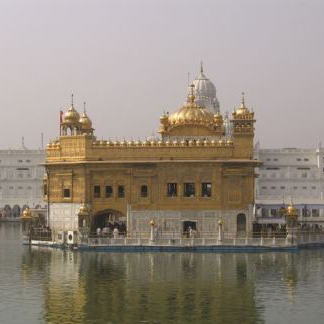
Sikh Scripture and Inter-Religious Community
"O Nanak, He Himself creates them and makes them different. Who shall we say is bad for all have the same Master."
GURU GRANTH SAHIB (1237)
When I joined the Santa Clara University faculty in 1986, I was full of mixed feelings. I was excited to teach at this reputable school that excels in teaching the whole person, but was apprehensive about how a person like me, who is not only a non-Catholic but culturally and visibly different, would fit into this environment. My apprehension soon evaporated.
Santa Clara’s Jesuit tradition of education promotes mutual respect and tolerance for all members of the community. I felt relieved as I discovered that there is no conflict in being a good Sikh, a good American, and a good teacher at a Jesuit school. My Sikh tradition enjoins me to hard work and sharing and caring in the name of God Almighty for the establishment of a just society for all humankind. A deeper look into the Guru Granth Sahib, the teaching of my sacred scripture, further reinforced my realization that I could belong within a Jesuit university and participate in a shared commitment towards the betterment of all humanity.
The Sikh scriptures, the Guru Granth Sahib, were compiled by the founders, known as “Gurus” of the Sikh religion over a period of some 230 years (1478-1708). There are two unique features of this sacred scripture. First, it is primarily a collection of devotional hymns. All hymns are set in musical verse to sing to the glory of God, with universal brotherhood/ sisterhood, harmony, tolerance, humility, and truthfulness as central themes. Second, throughout the hymns of the Guru Granth Sahib the emphasis is placed on the equality of all peoples regardless of religion, race, gender, or class. In fact, the scriptures contain not only the hymns of Sikh Gurus (the founders), but also the hymns and writings of God-devotees from other faiths. Since it was collated, dictated, edited, proofread and signed for authenticity by the founder Gurus themselves, and the original and the final copy is preserved in India, the authenticity of this holy scripture has never been in doubt; the entire contents of Sikh scriptures are held with great reverence by all in the community. Thus, in so far as Sikhs accept their scriptures as revelatory, we cannot believe that one race or religion is better than others. Rather, Sikhs accept all faiths as part of God’s creation. Consider the teaching of Siri Guru Granth Sahib: “Don’t say the Vedas and the Books (Torah, Bible, Qur’an) are false. False is the one who does not study them.”(1) And “Who can we call bad or good when all are Your creatures?”(2)

According to an underlying message of Guru Granth Sahib, God created all and abides in all. God is the common father/mother and we should see God pervading everything and everyone. The Guru Granth Sahib is inherently committed to religious harmony and cooperation. In fact, Sikh temples, known as Gurdwara, have always been open to all, regardless of one’s religious commitment. Because of this teaching and practice in the Sikh tradition, when I arrived at Santa Clara, I began to join most of the gatherings in the Mission Church. What a peaceful and loving atmosphere I felt when inside! When I gathered with other members of the Santa Clara community there, some of the teachings and reflections from my own scriptures would flash across my mind. Since the Guru Granth Sahib is largely a collection of devotional hymns which are set in musical verse to sing the glory of God, I found the music inside the church resonant and uplifting. Furthermore, since the Sikh scripture contains not only the hymns of Sikh Gurus (the founder teachers), but also the writings and hymns of God-devotees from other faiths, I found deep consolation whenever I would hear our then President, Fr. Paul Locatelli, S.J., speak publicly about the many ways in which Santa Clara is committed to religious harmony and cooperation. I have been shown no discrimination on the basis of my race and religion. My whole person has been welcomed here. In fact, in the School of Engineering, I was repeatedly and unanimously asked by my department faculty and the dean of the School of Engineering to lead the Department of Civil Engineering, and I remained department chair for fifteen years. During this time, I put my heart and soul into the development of the department. I added a structural engineering lab, an environmental lab, and a design and analysis room, and I raised money to add to the existing concrete lab and strength of materials labs. In collaboration with others, I also expanded the department’s offerings by hiring additional faculty to offer wider and higher levels of education to our civil engineering students. All of this was possible because Santa Clara allowed me to remain grounded in my own identity and commitments as a Sikh, practicing my faith and the moral and ethical values I am committed to uphold, while inviting me to realize my faith and identity through the University’s mission to educate “leaders of competence, conscience and compassion...building a more humane, just and sustainable world.”(3)
SUKHMANDER SINGH studied at Punjabi University (B.S.), Indian Institute of Technology (IIT), Delhi (M.S.), and University of California at Berkeley (Ph.D.). He is a Professor of Civil Engineering and a holder of the Nicolson Family Endowed Chair in Engineering at Santa Clara University.
Endnotes
- Guru Granth Sahib, 1350. Translations of Guru Granth Sahib in English, French, Spanish, Punjabi, Hindu, Sindhi & German are available. More recently, the text in its original font is available electronically on many websites. For more information contact SGPC, Amritsar, India.
- Guru Granth Sahib, 383.
- See Santa Clara University Vision Statement at http://www.scu.edu/jesuit/University-Mission.cfm